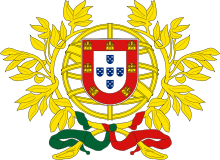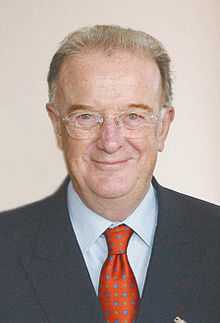President of Portugal
| President of the Portuguese Republic | |
|---|---|
|
| |
|
| |
| Style | His/Her Excellency |
| Residence | Belém Palace |
| Term length | Five years; maximum two consecutive terms (three if not consecutive). |
| Inaugural holder | Manuel de Arriaga |
| Formation | 5 October 1910 |
| Website | http://www.presidencia.pt/ |
 |
| This article is part of a series on the politics and government of Portugal |
| Constitution |
|
Presidency |
|
|
Legislative |
| Foreign relations |
|
Politics portal |
The President of the Portuguese Republic (Presidente da República Portuguesa, Portuguese pronunciation: [pɾɨziˈðẽtɨ ðɐ ʁɛˈpuβlikɐ]) is the head of state of Portugal.
Role
The President theoretically has wide powers, but most are rarely used, following the precedent set by President António Ramalho Eanes (1976–1986) and upheld by his successors Mário Soares and Jorge Sampaio.
The President, however, has the discretionary power to dissolve Parliament when he sees fit, and President Sampaio made use of this prerogative in late 2004 to remove the controversial government of Pedro Santana Lopes, despite the absolute majority of MPs supporting the government.
Prior to the Carnation Revolution, the powers of the presidency varied widely; some presidents were virtual dictators (such as Pais, and Carmona in his early years), while others were little more than figureheads (such as Carmona in his later years, Craveiro Lopes, and Américo Thomaz; during their administrations, supreme power was held by Prime Minister António de Oliveira Salazar).
Election
Under the Portuguese Constitution adopted in 1976, in the wake of the 1974 Carnation Revolution, the President is elected to a five-year term; there is no limit to the number of terms a president may serve, but a president who serves two consecutive terms may not serve again in the next five years after the second term finishes or in the following five years after his resignation.[1] The official residence of the Portuguese President is the Belém Palace.
The President is elected in a two-round system: if no candidate reaches 50% of the votes during the first round, the two candidates with the most votes face each other in a second round held two weeks later. However, the second round has only been needed once, during the 1986 presidential election. To date, all of the elected presidents since the Carnation Revolution have served for two consecutive terms, and presidents consistently rank as the most popular political figure in the country. Recently, however, the popularity of the current president Cavaco Silva has plummeted, making him the second-least popular political figure in the country, just above the Prime Minister, and the first Portuguese President after 1974 to have a negative popularity.[2]
If the president dies or becomes incapacitated while in office, the President of the Assembly assumes the office with restricted powers until a new president can be inaugurated following fresh elections.
2011 presidential election
Summary of the 23 January 2011 Portuguese presidential election results
| Candidates | Supporting parties | First round | ||
|---|---|---|---|---|
| Votes | % | |||
| Aníbal Cavaco Silva | Social Democratic Party, People's Party, Hope for Portugal Movement | 2,231,956 | 52.95 | |
| Manuel Alegre | Socialist Party, Left Bloc, Democratic Party of the Atlantic, Workers' Communist Party | 831,838 | 19.74 | |
| Fernando Nobre | Independent | 593,021 | 14.07 | |
| Francisco Lopes | Portuguese Communist Party, Ecologist Party "The Greens" | 301,017 | 7.14 | |
| José Manuel Coelho | New Democracy Party | 189,918 | 4.51 | |
| Defensor Moura | Independent | 67,110 | 1.59 | |
| Total valid | 4,214,860 | 100.00 | ||
| Blank ballots | 192,127 | 4.28 | ||
| Invalid ballots | 85,466 | 1.90 | ||
| Total (turnout 46.52%) | 4,492,453 | |||
| Source: Comissão Nacional de Eleições | ||||
State visits
The President of Portugal often makes official state visits to other foreign countries. For a list of visits made by President Cavaco Silva see:
Living former Presidents
There are three living former Portuguese Presidents:
- Living former Presidents
-
.jpg)
António Ramalho Eanes GColTE, GCL, CavA, KE
served 1976–1986, born 1935 -
.jpeg)
Mário Nobre Lopes Soares GColTE GCC GColL KE
served 1986–1996, born 1924 -

Jorge Sampaio GColTE, GCIH, GColL
served 1996–2006, born 1939
See also
References
- ↑ "Constitution of the Portuguese Republic". Assembly of the Republic. 2005. Retrieved June 6, 2014.
- ↑ Cavaco é o primeiro PR com popularidade negativa (Portuguese)
External links
| ||||||

